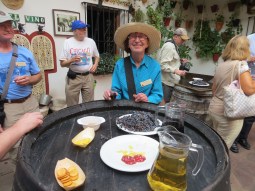On a beautiful Monday, our next-to-last one before leaving for home, we drove a Avis rental between Avignon & the Camargue. The Camargue is an extensive wet-lands area starting about 30 miles south of Avignon and is feed, in part, by the Rhone River and bordering the Mediterranean Sea. It is favored by migrating birds and ranchers who raise horses & cattle, and bulls for a regional favorite, Bull Racing!
We had great lunch in Les Saintes-Maries-de-la-Mer on a land spur along the Med coast. Then we took the Tiki III tour boat up the adjacent waterway where we could watch birds & river life and cattle, horses and a cowgirl (called a Gardian). There’s an historic fortress-like church in town which dominates the skyline near town, but we didn’t have time to visit it.
As the sunlight dwindled, lighting up the clouds with brilliant shades of reds, we stopped at the bird sanctuary called Parc Ornithologique du Pont-de-Gau. It has an unassuming frontage next to other businesses, but opens to an extensive wet-lands sanctuary which was hosting thousands of pink flamingos and others birds & wildlife. We could hear a duck-like chatter coming before we could see the thousands of noisy pink flamingos in this protected section of the Camargue. The flamingos were being feed from a small vehicle that slowly circled this shallow lake area and at every stop the flamingos would follow in unison to the fresh source where their heads would plunge under the water for food, so we saw them in almost constant motion.
The critter food was something that looked like rice and it attracted ducks, fish & the local beaver (or else it was a very large rat), but the flamingos crowded out the pond. The flamingos were very entertaining to watch, especially their amazing propensity to all gracefully move in the same direction as if choreographed. This was happening in a network of ponds & islands covering probably hundreds of acres with networks of walkways ringing the marshy habitat. We moved to an adjacent large marsh area which was placid & calm with ducks & herons nesting for the night — until the flights of well-feed flamingos started coming in as the sun set.
































































































